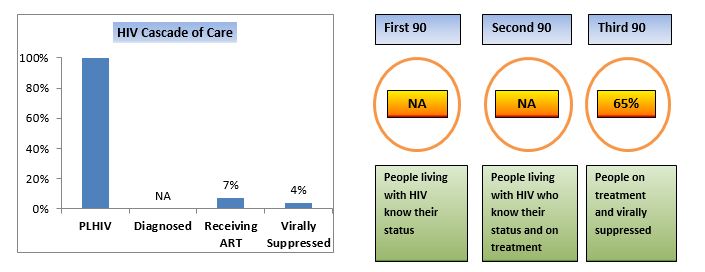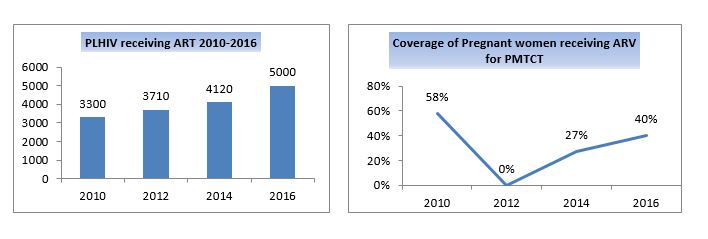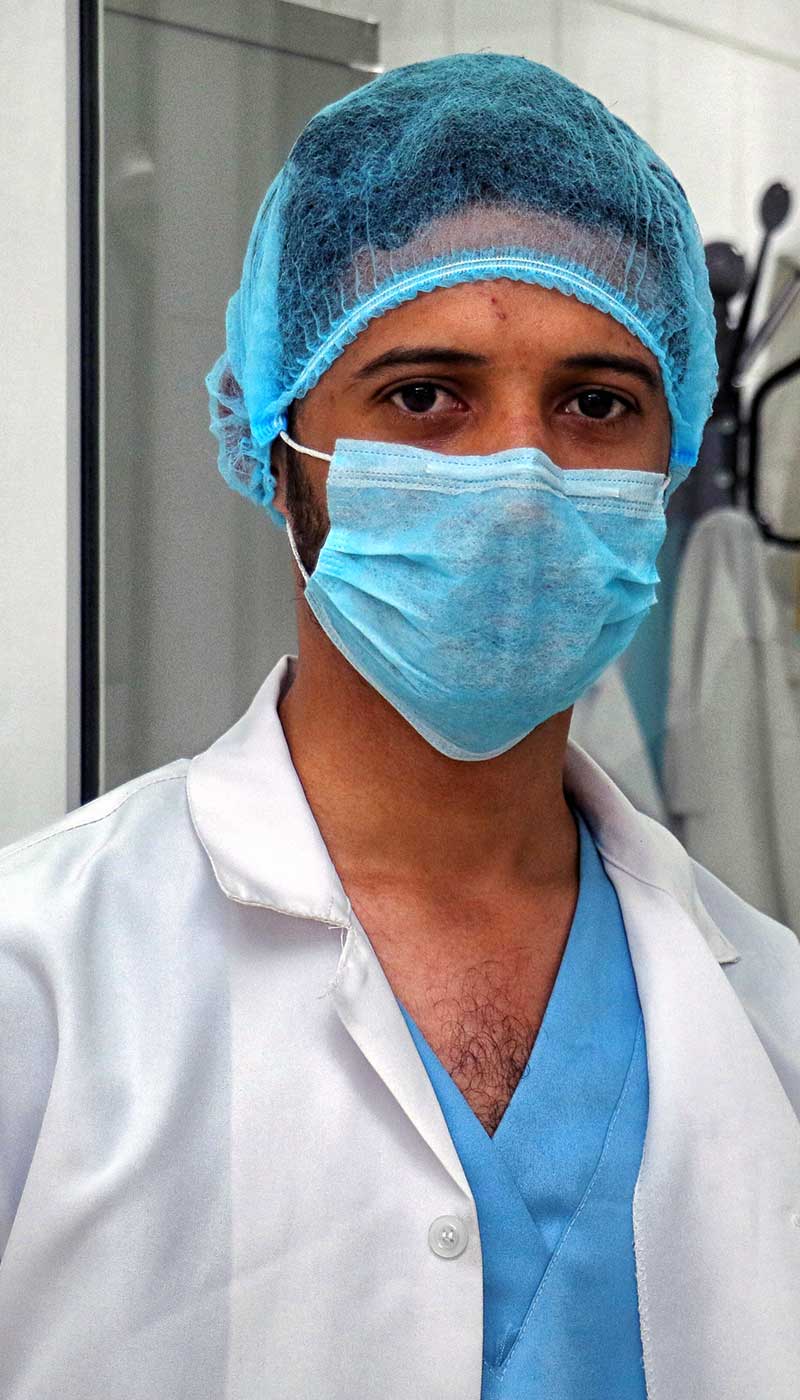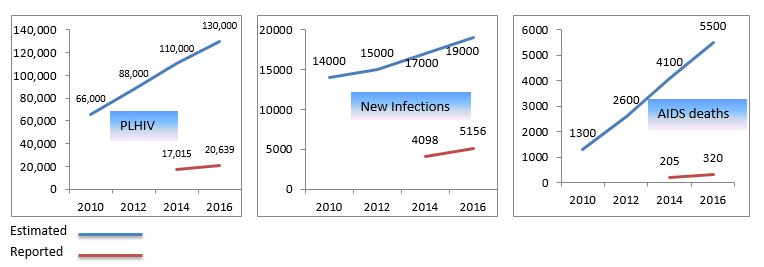Pakistan HIV country profile
Sociodemographic data
- Total population (in millions) : 192.8
- Maternal mortality per 100 000 live births :178
- Life expectancy at birth (years) : 66
- Total fertility rate (births per woman) : 3.7
- GNI per capita, PPP (current international US$) :5 320
- Health expenditure, total (% of GDP) : 2.6
- Health expenditure per capita (current US$) : 36
- Human Development Index Value :0.55
HIV care cascade and progress towards 90-90-90

Epidemiological data (2016)
HIV estimates and case notification
|
|
Estimated |
Reported |
|
HIV prevalence in general population |
0.1 |
|
|
People living with HIV (PLHIV) |
130 000 [120 000 - 150 000] |
20 639 |
|
New infections |
19 000 [17 000 - 21 000] |
5156 |
|
AIDS-related deaths |
5500 [4500 - 6600] |
320 |
|
|
|
|
HIV in specific populations
|
|
Survey data |
|
Size estimate |
Routine testing and VCT data |
|
|
Key populations |
Prevalence |
|
|
No tested |
HIV+ cases (%) |
|
Sex workers (SW) |
2.2 cluster sampling- (n=72,364)/ 2016 |
|
136 000 (2011) |
||
|
Men having sex with men (MSM) |
5.4% (n=6773) |
|
|||
|
People who inject drugs (PWIDs) |
38.4% (n=7862) |
|
99 000 (2011) |
||
|
Prisoners |
NA |
|
|||
|
Populations in health settings |
|
|
|
|
|
|
TB patients |
|
|
|
||
|
Pregnant women |
.03% (n=26,510/ 42 sites in 9 districts, 2010 |
|
|
||
|
Blood Donors |
|
|
|
||
|
Clients of testing services |
|
|
|
||
Response
Policy implementation
|
|
|
|
Policy CD4 threshold adults and adolescents |
Treat all |
|
Recommended initiation threshold children |
Treat all |
|
Policy of lifelong ART to pregnant & breastfeeding women |
Option B+ |
|
Implementation of lifelong ART to pregnant & breastfeeding women |
Done in a small number of MCH sites |
|
Implementation of national policy on viral load monitoring |
Not implemented |
HIV testing coverage in key populations *
 Antiretroviral therapy and PMTCT coverage
Antiretroviral therapy and PMTCT coverage
References
1 http://www.prb.org/pdf16/prb-wpds2016-web-2016.pdf; (2) WHO.EMRO Regional Surveillance Data; (3) WHO/UNAIDS data spectrum 2016; (4) Global AIDS Monitoring (GAM) 2016.*These are approximate estimations based on the latest available data for number of people tested and size estimates.
WHO concerned about suspected chemical attacks in Syria
WHO is deeply alarmed by reports of the suspected use of toxic chemicals in Douma city, East Ghouta. According to reports from Health Cluster partners, during the shelling of Douma on Saturday, an estimated 500 patients presented to health facilities exhibiting signs and symptoms consistent with exposure to toxic chemicals. In particular, there were signs of severe irritation of mucous membranes, respiratory failure and disruption to central nervous systems of those exposed.
Note verbale documents

Extensive activities were undertaken to strengthen countries’ preparedness for emergencies. A joint external evaluation (JEE) was conducted in Iraq to assess the country’s public health capacities to deal with all hazards under the International Health Regulations (2005). This brings to 18 the number of countries in the Region that have undergone JEEs, with evaluations in the Islamic Republic of Iran, Palestine, the Syrian Arab Republic and Yemen set to complete the tally.
JEEs provide the basis for each country to develop a national action plan for health security (NAPHS) tailored to its specific needs. As part of follow-up work in 2019, workshops were organized by WHO and attended by representatives of public institutions and partner organizations, with participants teaming up to across 19 technical areas of the IHR to address the recommendations that came out of previous JEEs. Djibouti, Egypt, Tunisia and the United Arab Emirates developed their NAPHS.
In addition to this support for individual countries, cross-border and regional preparedness were important areas of focus. WHO collaborated with country offices of the Food and Agriculture Organization of the United Nations and national ministries of public health, animal health and environment to conduct tripartite joint risk assessments for Afghanistan and Pakistan. Staff from national and subnational offices practiced shared health threats at the human–animal–environment interface using a “One Health” approach.
As part of ongoing efforts to support countries in maintaining IHR core capacities at points of entry, WHO collaborated with the United States Centers for Disease Control and the International Organization for Migration to develop a new Handbook for public health capacity building and cross-border collaboration at ground crossings. This global resource was pilot tested through a comprehensive three-day programme of discussions in Beirut, Lebanon, with national IHR focal points, senior officials working directly with public health issues at ground crossings, participants from relevant sectors, and WHO’s sister UN agencies.
Further action on cross-border security included training for personnel from Bahrain, Saudi Arabia and United Arab Emirates on public health capacity-building and cross border collaboration at ground crossings, and a review of ground crossings in Egypt to ensure preparedness following a Rift Valley fever outbreak in Sudan.
At the end of the year, the eighth regional stakeholders meeting brought together more than 140 participants from Member States to review the implementation of the IHR. The meeting provided a platform for the introduction of several new tools and innovations to support IHR implementation, including training packages and tools for NAPHS prioritization, monitoring and evaluation. Recommendations addressed enhancing multisectoral collaboration, determining priority areas, increasing capacity-building activities and continuing knowledge exchange between countries, with WHO reaffirming its commitment to provide ongoing technical support.
Key outcomes of the meeting will feed into the first health security diplomacy meeting, set to take place in 2020, which will provide a high-level forum for continuing multisectoral collaboration and coordination for IHR implementation.




